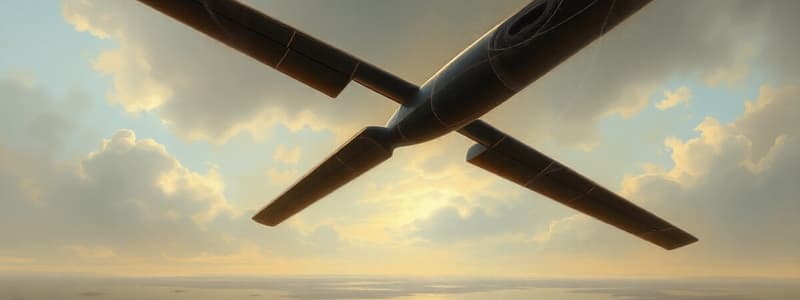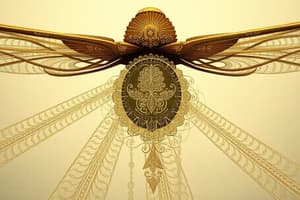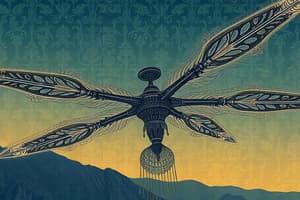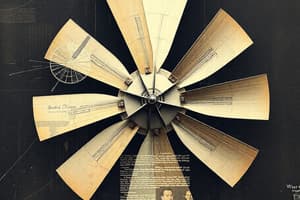Podcast
Questions and Answers
Which blade design is characterized by having higher camber on one side than the other?
Which blade design is characterized by having higher camber on one side than the other?
- Asymmetrical (correct)
- Symmetrical
- Curved
- Straight
What is the main reason symmetrical blades are the most common design?
What is the main reason symmetrical blades are the most common design?
- They offer more stability compared to asymmetrical blades. (correct)
- They are easier to manufacture.
- They are lighter in weight.
- They produce greater lift.
Which planform has leading and trailing edges that run parallel to each other?
Which planform has leading and trailing edges that run parallel to each other?
- Uniform (correct)
- Converging
- Tapered
- Diverging
What is a disadvantage of using a single pocket skin configuration?
What is a disadvantage of using a single pocket skin configuration?
What happens when weight is added aft of the trim tabs?
What happens when weight is added aft of the trim tabs?
Which blade planform produces more equal lift across its length?
Which blade planform produces more equal lift across its length?
What material is most commonly used for rotor blades?
What material is most commonly used for rotor blades?
How do engineers achieve the same pitching characteristics from an asymmetrical blade?
How do engineers achieve the same pitching characteristics from an asymmetrical blade?
Which type of blades are required to have static discharge abilities?
Which type of blades are required to have static discharge abilities?
Before rigging a helicopter, what should be done first?
Before rigging a helicopter, what should be done first?
Why do tapered planforms require a different rib number for each rib?
Why do tapered planforms require a different rib number for each rib?
Where are chordwise mass balance weights located?
Where are chordwise mass balance weights located?
What happens if weight is added forward to the trim tab?
What happens if weight is added forward to the trim tab?
What is the primary inspection method for composite rotor blades?
What is the primary inspection method for composite rotor blades?
What is the purpose of painting the bottom of rotor blades flat black?
What is the purpose of painting the bottom of rotor blades flat black?
What effect does bending the trim tab higher have on the rotor blade's flight?
What effect does bending the trim tab higher have on the rotor blade's flight?
What must be ensured before connecting the collective and throttle together?
What must be ensured before connecting the collective and throttle together?
What is the correct order to rig the flight controls?
What is the correct order to rig the flight controls?
What does the main servo flap do?
What does the main servo flap do?
Which system is more complex, droop compensator or correlator?
Which system is more complex, droop compensator or correlator?
What does the droop compensator accomplish?
What does the droop compensator accomplish?
What are the two vibration absorbing devices mentioned?
What are the two vibration absorbing devices mentioned?
In a fixed elevator scenario, what type of airfoil is used?
In a fixed elevator scenario, what type of airfoil is used?
What does the elevator do for the helicopter's flight attitude?
What does the elevator do for the helicopter's flight attitude?
Flashcards
Symmetrical rotor blade
Symmetrical rotor blade
The design where both sides of the blade have the same curvature.
Asymmetrical rotor blade
Asymmetrical rotor blade
The design where one side of the blade has a higher curvature than the other.
Which design has greater lift?
Which design has greater lift?
A blade design that produces greater lift for the same surface area.
Chord line
Chord line
Signup and view all the flashcards
Uniform planform
Uniform planform
Signup and view all the flashcards
Tapered planform
Tapered planform
Signup and view all the flashcards
Bonded construction
Bonded construction
Signup and view all the flashcards
Single pocket skin
Single pocket skin
Signup and view all the flashcards
Weight on the trailing edge
Weight on the trailing edge
Signup and view all the flashcards
Weight on the leading edge
Weight on the leading edge
Signup and view all the flashcards
Weight aft of trim tabs
Weight aft of trim tabs
Signup and view all the flashcards
Rotor blade leading edge protection
Rotor blade leading edge protection
Signup and view all the flashcards
Static discharge in composite blades
Static discharge in composite blades
Signup and view all the flashcards
Composite blade inspection
Composite blade inspection
Signup and view all the flashcards
Multi-pocket blade skin
Multi-pocket blade skin
Signup and view all the flashcards
Spanwise balance weights
Spanwise balance weights
Signup and view all the flashcards
What is the servo tab?
What is the servo tab?
Signup and view all the flashcards
What does the main servo flap do?
What does the main servo flap do?
Signup and view all the flashcards
What are the benefits of the servo flap?
What are the benefits of the servo flap?
Signup and view all the flashcards
What is the correct order that we rig the flight controls in?
What is the correct order that we rig the flight controls in?
Signup and view all the flashcards
What does the droop compensator do?
What does the droop compensator do?
Signup and view all the flashcards
What is the correlator?
What is the correlator?
Signup and view all the flashcards
What are the two different vibration absorbing devices?
What are the two different vibration absorbing devices?
Signup and view all the flashcards
In a force trim system device what returns the cyclic to its previous position?
In a force trim system device what returns the cyclic to its previous position?
Signup and view all the flashcards
Study Notes
Rotor Blade Designs
- Two main rotor blade designs exist: symmetrical and asymmetrical.
- Symmetrical blades have better aerodynamic pitch characteristics.
- Asymmetrical blades produce more lift for the same surface area.
- Asymmetrical blades have higher camber on one side.
- Engineers achieve similar pitching characteristics in asymmetrical blades by sweeping the edges upward (3 degrees). This improves aerodynamic stability.
- Symmetrical blades are the most common design due to their greater aerodynamic stability.
- Two main planform types exist: parallel (uniform) and tapered.
- Uniform planforms have leading and trailing edges parallel to each other.
- Uniform planforms generally create greater lift due to their chord line.
- Tapered planforms have a converging leading and trailing edge, with a decreasing chord length towards the root.
- Manufacturers prefer uniform planforms due to cost-effectiveness, needing only one machine stamping for ribs, and maintaining a consistent chord length.
- Tapered planforms require different rib numbers for each rib due to varying chord length.
- Tapered planforms provide more equal lift across the blade's length due to their ability to account for varying speed.
- Parallel blades have negative twist to achieve appropriate angle of attack (AOA) at the root and tip, compensating for varying blade rotational speeds.
Rotor Blade Skin Configurations
- Single-pocket skin configurations are faster to build due to a larger single skin section and less concern about rib placement.
- Multi-pocket skin configurations are easier to repair due to replaceable individual segments.
- If a single-pocket skin is damaged, the entire section is replaced.
- Bonded construction is preferred for strength, eliminating the need for drilling holes.
Rotor Blade Mass Balance Weights
- Chordwise mass balance weights are located within 30-50% of the leading edge.
- Spanwise balance weights are centrally located at the blade tip.
- Tracking balance weights are positioned towards the leading and trailing edges.
- Adding weight toward the leading edge results in a lowered flight path.
- Adding weight toward the trailing edge results in a higher flight path.
- Trim tabs are used to adjust flight attitude; this is generally easier to implement than repositioning permanent weights.
Helicopter Flight Controls
- Collective and cyclic controls, and anti-torque pedals are rigged in order; collective first, followed by cyclic, ending with anti-torque pedals.
- Before connecting collective and throttle, ensure individual rigging for accurate operation.
Servo Tabs
- Servo tabs are airfoil shaped panels (75% span) affixed to the trailing edge of rotor blades to allow for increased aerodynamic efficiency.
- Servo tabs simplify the hub, eliminating the need for hydraulics, allowing for quieter operation.
- Servo tabs increase autorotation reaction time.
Droop Compensator and Correlator
- The droop compensator is a mechanism for governing the governor's output.
- A correlator establishes a mechanical link between the collective and throttle, adjusting the linkage between the two.
- The correlator mechanism prevents lag or delay during power adjustments.
Helicopter Vibration Absorbers
- Two main vibration absorber types exist: bifilar and hub vibration absorbers.
- Bifilar absorbers have four arm disks to dampen vibrations.
Rotor Blade Systems
- Force trim systems return cyclic controls to their original positions.
- Gradient springs position the cyclic.
- Elevator function adjusts the attitude direction.
- Inverted airfoil configuration provides downward lift.
- Fixed-elevator helicopters use inverted airfoils for downward lift control.
Studying That Suits You
Use AI to generate personalized quizzes and flashcards to suit your learning preferences.




